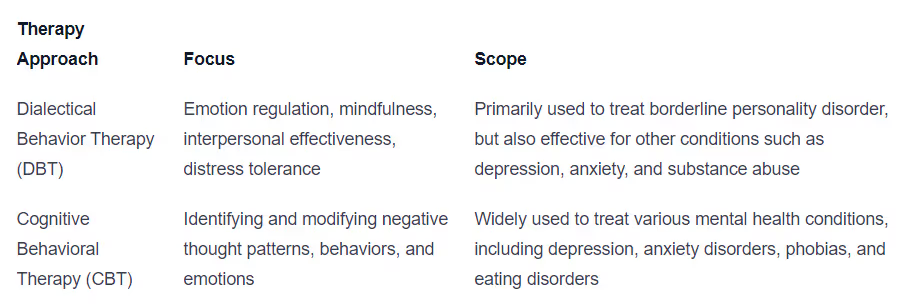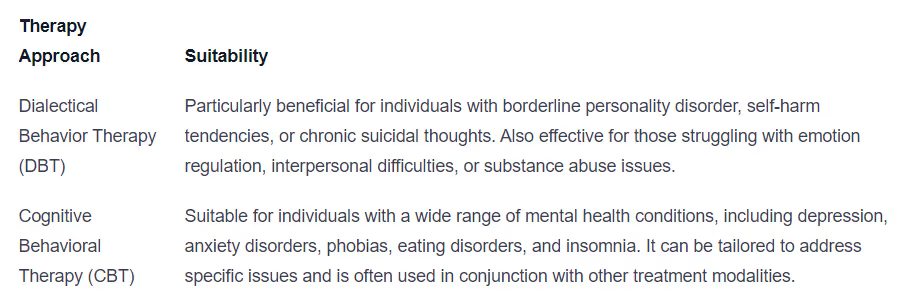Dialectical Behavior Therapy vs. Cognitive Behavioral Therapy

Understanding Therapy Approaches
When it comes to therapy, there are various approaches available to address different mental health concerns. Two commonly used therapeutic approaches are Dialectical Behavior Therapy (DBT) and Cognitive Behavioral Therapy (CBT). Both DBT and CBT aim to help individuals improve their well-being and manage emotional distress, but they differ in their focus and techniques.
Introduction to Dialectical Behavior Therapy (DBT)
Dialectical Behavior Therapy (DBT) was developed by psychologist Marsha M. Linehan to treat individuals with borderline personality disorder. Over time, it has been expanded to help individuals with other mental health conditions, such as depression, anxiety, and substance abuse.
DBT is known for its dialectical philosophy, which emphasizes finding a balance between acceptance and change. It combines elements of mindfulness, acceptance, and cognitive-behavioral techniques to help individuals regulate emotions, cope with stress, and improve interpersonal relationships.
Introduction to Cognitive Behavioral Therapy (CBT)
Cognitive Behavioral Therapy (CBT) is a widely used therapeutic approach that focuses on the connection between thoughts, feelings, and behaviors. It aims to identify and modify negative patterns of thinking and behavior that contribute to emotional distress.
CBT is based on the idea that our thoughts influence our emotions and behaviors. By challenging and replacing negative thoughts with more positive and realistic ones, individuals can experience improved mental well-being. CBT also incorporates behavioral techniques, such as exposure therapy and behavioral experiments, to help individuals overcome specific challenges.
Understanding the basics of DBT and CBT provides a foundation for exploring their key features and comparing their effectiveness in addressing different mental health concerns.
Key Features of Dialectical Behavior Therapy
Dialectical Behavior Therapy (DBT) is a therapeutic approach that focuses on helping individuals develop skills to manage their emotions, improve relationships, and cope with challenging situations. It combines elements of cognitive-behavioral therapy with concepts from Eastern philosophies. Let's explore the goals, objectives, and core components of DBT.
Goals and Objectives of DBT
The primary goal of DBT is to help individuals create a life worth living. It aims to achieve this by targeting specific objectives:
- Reducing self-destructive behaviors: DBT focuses on decreasing harmful behaviors such as self-harm, suicidal ideation, and substance abuse. The therapy provides techniques and strategies to replace these behaviors with healthier alternatives.
- Enhancing emotional regulation: DBT aims to improve emotional regulation skills, helping individuals effectively identify, understand, and manage their emotions. This includes learning to tolerate distressing emotions without resorting to destructive behaviors.
- Developing interpersonal effectiveness: DBT emphasizes the development of healthy interpersonal skills and communication techniques. This includes learning how to set boundaries, express needs, and maintain positive relationships.
- Increasing mindfulness: Mindfulness is a core component of DBT. It involves cultivating non-judgmental awareness of the present moment, allowing individuals to observe their thoughts, feelings, and sensations without reacting impulsively.
Core Components of DBT
DBT consists of several core components that work together to achieve the therapy's goals:
- Individual therapy: In individual therapy sessions, individuals work one-on-one with their therapist to address specific challenges and develop strategies for managing emotions and behaviors. These sessions typically focus on problem-solving, skills training, and applying learned techniques to real-life situations.
- Group skills training: DBT includes group skills training sessions where individuals learn and practice skills related to mindfulness, distress tolerance, emotion regulation, and interpersonal effectiveness. These group sessions provide a supportive environment for individuals to learn from one another and gain valuable insights.
- Phone coaching: To provide additional support between therapy sessions, DBT often includes phone coaching. Individuals are encouraged to reach out to their therapists for guidance and assistance in applying the skills they have learned when facing challenging situations.
- Consultation team: DBT therapists participate in consultation teams where they receive ongoing supervision and support. These teams ensure that therapists adhere to the principles of DBT and provide high-quality treatment to their clients.
By understanding the goals, objectives, and core components of DBT, individuals can make more informed decisions when considering this therapy approach. The next section will explore the key features of Cognitive Behavioral Therapy (CBT), allowing for a comprehensive comparison between the two approaches.
Key Features of Cognitive Behavioral Therapy
Cognitive Behavioral Therapy (CBT) is a widely used therapeutic approach that focuses on the connection between thoughts, emotions, and behaviors. Let's explore the key features of CBT, including its goals and objectives, as well as its core components.
Goals and Objectives of CBT
The primary goal of Cognitive Behavioral Therapy is to identify and modify negative or unhelpful thought patterns and behaviors that contribute to psychological distress. The objectives of CBT include:
- Developing awareness of one's thoughts and beliefs
- Recognizing the influence of thoughts on emotions and behaviors
- Challenging and reframing negative or distorted thinking
- Acquiring effective coping skills and problem-solving strategies
- Facilitating behavioral changes that lead to improved mental well-being
By working towards these goals, individuals undergoing CBT can gain a better understanding of their thoughts, emotions, and behaviors, and learn how to make positive changes to enhance their overall quality of life.
Core Components of CBT
Cognitive Behavioral Therapy consists of several core components that are integral to its effectiveness. These components include:
- Cognitive Restructuring: This component involves identifying and challenging negative or irrational thoughts, beliefs, and assumptions. By replacing them with more rational and positive alternatives, individuals can reduce distress and improve their emotional well-being.
- Behavioral Activation: This component focuses on increasing engagement in positive and rewarding activities. By identifying and modifying behaviors that contribute to negative emotions or withdrawal, individuals can regain a sense of pleasure and achievement in their lives.
- Skills Development: CBT often emphasizes the acquisition of specific skills to cope with challenges and manage emotions effectively. These skills may include relaxation techniques, problem-solving strategies, assertiveness training, and social skills development.
- Homework Assignments: CBT frequently involves assigning homework to clients to practice and reinforce the skills learned during therapy sessions. These assignments serve as an opportunity for individuals to apply new strategies in real-life situations, promoting lasting change and progress.
The combination of these core components in Cognitive Behavioral Therapy allows individuals to gain insight, challenge negative thinking patterns, develop healthier coping mechanisms, and make positive changes in their lives.
Understanding the key features of Cognitive Behavioral Therapy is essential when considering therapy options. In the next section, we will compare Dialectical Behavior Therapy (DBT) and Cognitive Behavioral Therapy to help you make an informed decision based on your individual needs and preferences.
Comparing Dialectical Behavior Therapy and Cognitive Behavioral Therapy
When considering therapy options, it's important to compare different approaches to determine which one aligns best with your needs and goals. In this section, we will compare Dialectical Behavior Therapy (DBT) and Cognitive Behavioral Therapy (CBT) in terms of focus and scope of treatment, techniques and strategies used, and suitability for different individuals.
Focus and Scope of Treatment

DBT focuses on helping individuals regulate their emotions, develop mindfulness skills, improve interpersonal relationships, and enhance distress tolerance. It was initially developed to treat borderline personality disorder but has since been found effective for other conditions as well.
CBT, on the other hand, concentrates on identifying and modifying negative thought patterns, behaviors, and emotions. It is widely used to address various mental health conditions, including depression, anxiety disorders, phobias, and eating disorders.
Techniques and Strategies Used

DBT employs a combination of techniques and strategies, including skills training, individual therapy, group therapy, phone coaching, and the use of diary cards to monitor progress. These elements help individuals develop coping skills, regulate emotions, and improve interpersonal relationships.
CBT utilizes techniques such as cognitive restructuring to challenge and modify negative thought patterns, behavioral activation to increase engagement in positive activities, exposure therapy to confront fears and anxieties, and relaxation techniques to manage stress and anxiety.
Suitability for Different Individuals

DBT is especially well-suited for individuals with borderline personality disorder, self-harm tendencies, chronic suicidal thoughts, emotion regulation difficulties, interpersonal challenges, or substance abuse issues. It provides a comprehensive approach to address these specific issues.
CBT, on the other hand, is suitable for individuals with various mental health conditions, including depression, anxiety disorders, phobias, eating disorders, and insomnia. It can be adapted to target specific issues and is often used alongside other treatment modalities.
When choosing between DBT and CBT, it's important to consider your specific needs, the nature of your condition, and your treatment goals. Consulting with a qualified therapist can provide further guidance and help determine which approach is most suitable for you.
Factors to Consider When Choosing Between DBT and CBT
When deciding between Dialectical Behavior Therapy (DBT) and Cognitive Behavioral Therapy (CBT), several factors should be taken into consideration. It's important to assess individual needs and preferences, therapist availability and expertise, as well as treatment goals and targeted issues.
Individual Needs and Preferences
One of the key factors to consider when choosing between DBT and CBT is your individual needs and preferences. Each therapy approach has its own unique characteristics and focuses on different aspects of treatment.
If you prefer a therapy approach that addresses emotional regulation, self-acceptance, and interpersonal skills, DBT may be a suitable choice. DBT specifically targets individuals who struggle with intense emotions, self-destructive behaviors, and difficulties in maintaining healthy relationships.
On the other hand, if you prefer a therapy approach that emphasizes the connection between thoughts, emotions, and behaviors, CBT might be more suitable. CBT focuses on identifying and challenging negative patterns of thinking and behavior to promote positive change.
Therapist Availability and Expertise
Another crucial factor to consider is the availability and expertise of therapists trained in DBT and CBT. Both therapy approaches require specialized training and knowledge. It's important to ensure that the therapist you choose has experience and expertise in the specific therapy approach you are interested in.
Therapist availability may also play a role in your decision-making process. Depending on your location, it may be easier to find therapists who specialize in CBT compared to DBT, or vice versa. Consider the practicality and accessibility of each therapy approach within your specific circumstances.
Treatment Goals and Targeted Issues
The treatment goals and targeted issues you wish to address should also be taken into account when choosing between DBT and CBT. While both approaches can be effective for various mental health conditions, certain issues may align more closely with one therapy approach than the other.
DBT is commonly used to treat borderline personality disorder, self-harm behaviors, and chronic suicidal thoughts. It focuses on building skills for emotional regulation, distress tolerance, and interpersonal effectiveness.
CBT, on the other hand, is widely applicable and can be used to address a range of mental health issues, including anxiety disorders, depression, phobias, and eating disorders. It aims to identify and modify negative thought patterns and behaviors that contribute to distress.
By considering your specific treatment goals and the issues you want to target, you can make an informed decision about which therapy approach is most suitable for your needs.
It's important to remember that the choice between DBT and CBT is not necessarily mutually exclusive. In some cases, a combination of both approaches may be beneficial. Consulting with a mental health professional can provide valuable guidance in determining the most appropriate therapy approach based on your unique circumstances.
Conclusion
The decision to seek therapy can be a difficult one, and choosing the right approach can seem overwhelming. This article has provided an overview of two popular therapeutic approaches, Dialectical Behavior Therapy (DBT) and Cognitive Behavioral Therapy (CBT), including their goals, objectives, core components, and suitability for different individuals.
It's important to keep in mind that there is no one-size-fits-all approach when it comes to therapy. What works for one person may not work for another. It's crucial to consider individual needs, preferences, and treatment goals when deciding which approach to pursue.
Ultimately, the goal of any therapeutic approach is to provide individuals with the tools they need to cope with life's challenges effectively. Whether you choose DBT or CBT, the most important thing is that you take the first step towards seeking help and prioritize your mental health and well-being.
Sources:
- https://www.verywellhealth.com/dialectical-behavior-therapy-vs-cognitive-behavioral-therapy-uses-benefits-side-effects-and-more-5323767#:~:text=CBT%20and%20DBT%20are%20types,emotion%20regulation%2C%20and%20interpersonal%20relationships.
- https://www.skylandtrail.org/4-differences-between-cbt-and-dbt-and-how-to-tell-which-is-right-for-you/
- https://psychcentral.com/lib/whats-the-difference-between-cbt-and-dbt
